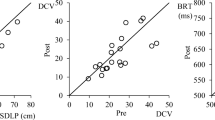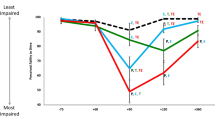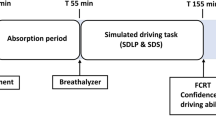Abstract
Rationale
The number of road fatalities related to the presence of amphetamines in drivers has been relatively constant over the past 10 years. However, there remains uncertainty as to the extent that these drugs induce driving impairment, and whether any such impairments translate to an increase in road fatalities.
Objectives
To examine the acute effects of 0.42 mg/kg dexamphetamine on simulated driving performance, and to establish which, if any, simulated driving abilities become impaired following dexamphetamine administration.
Methods
A repeated-measures, counter-balanced, double-blind, placebo-controlled design was employed. Twenty healthy volunteers completed two treatment conditions—0.42 mg/kg dexamphetamine and placebo. Performance was assessed using a driving simulator task. Blood and saliva samples were obtained prior to the driving tasks and immediately after task completion (120 min and 170 min post-drug administration, respectively).
Results
Mean dexamphetamine blood concentrations were 83 ng/ml and 98 ng/ml at 120 min and 170 min, respectively. Results indicated a decrease in overall simulated driving ability following dexamphetamine administration during the day-time but not the night-time scenario tasks. Contributing to this performance reduction, “incorrect signalling”, “failing to stop at a red traffic light” and “slow reaction times” were the behaviours most strongly affected by dexamphetamine.
Conclusions
The decrease in simulated driving ability observed during the day-time driving tasks are consistent with the perceptual narrowing or tunnel vision that is associated with dexamphetamine consumption.
Similar content being viewed by others
References
Adachi-Usami E (1990) Senescence of visual function as studied by visually evoked cortical potentials. Jpn J Ophthalmol 34(1):81–94
Angrist B, Corwin J, Bartlik B, Cooper T (1987) Early pharmacokinetics and clinical effects of oral d-amphetamine in normal subjects. Biol Psychiatry 22:1357–1368
Brauer LH, Ambre J, de Wit H (1996) Acute tolerance to subjective but not cardiovascular effects of d-amphetamine in normal healthy men. J Clin Psychopharmacol 16(1):72–76
Brookhuis KA, De Waard D et al (2004) Effects of MDMA (ecstasy), and multiple drugs use on (simulated) driving performance and traffic safety. Psychopharmacology (Berl) 173(3–4):440–445
Cami J, Farre M, Mas M, Roset P, Poudevida S, Mas A, San L, de la Torre R (2000) Human pharmacology of 3, 4-methylenedioxymeth-amphetamine (“Ecstasy”): psychomotor performance and subjective effects. J Clin Psychopharmacol 20(4):455–466
De Waard D, Brookhuis KA, Pernot LMC (2000) A driving simulator study ofthe effects of MDMA (Ecstasy) on driving performance and traffic safety.Proceedings of the International Council on Alcohol Drugs and TrafficSafety (ICADTS), Stockhom Sweden, May 2000
De Wit H, Enggasser JL, Richards JB (2002) Acute administration of d-amphetamine decreases impulsivity in healthy volunteers. Neuropsychopharmacology 27(5):813–825
Drummer OH, Gerostamoulos J, Batziris H, Chu M, Caplehorn J, Robertson MD, Swann P (2003a) The involvement of drugs in drivers of motor vehicles killed in Australian road traffic crashes. Accid Anal Prev 943:1–10
Drummer OH, Gerostamoulos J, Batziris H, Chu M, Caplehorn JRM, Robertson MD, Swann P (2003b). The incidence of drugs in drivers killed in Australian road traffic crashes. Forensic Sci Int 134:154–162
Easterbrook JA (1959) The effect of emotion on cue utilization and the organisation of behaviour. Psychol Rev 66(3):183–201
Evenden Jl, Ryan CN (1996) The pharmacology of impulsive behaviours in rats: the effects of drugs on response choice with varying delays of reinforcement. Psychopharmacology (Berl) 128:161–170
Feldman RS, Meyer JS, Quenzer LF (1997) Principles of neuropsychopharmacology. Sinauer Associates, Incorporated. Sunderland,MA
Fleming K, Bigelow LB, Weinberger DR, Goldberg TE (1995) Neuropsychological effects of amphetamine may correlate with personality characteristics. Psychopharmacol Bull 31(2):357–362
Halliday R, Naylor H, Brandeis D, Callaway E, Yano L, Herzig K (1994) The effect of d-amphetamine, clonidine, and yohimbine on human information processing. Psychophysiology 31:331–337
Hurst PM (1962) The effects of d-amphetamine on risk taking. Psychopharmacologia 3:283–290
Hurst PM, Weidner MF, Radlow R (1967) The effects of amphetamines upon judgement and decisions. Psychopharmacologia 1(5):397–404
Kupietz SS, Bartlik B, Angrist B, Winsberg BG (1985) Psychostimulant plasma concentration and learning performance. J Clin Psychopharmacol 5(5):293–295
Logan BK (1996) Methamphetamine and driving impairment. J Forensic Sci 41(3):457–464
Logan BK, Fligner CL et al (1998) Cause and manner of death in fatalities involving methamphetamine. J Forensic Sci 43(1):28–34
Mills KC, Spruill SE, Kanne RW, Parkman KM, Zhang Y (2001) The influence of stimulants, sedatives, and fatigue on tunnel vision: risk factors for driving and piloting. Hum Factors 43(2):310–327
Moeller MR, Kraemer T (2002) Drugs of abuse monitoring in blood for control of driving under the influence of drugs. Ther Drug Monit 24:210–221
Newcombe RG (1998) Improved confidence intervals for the difference between binomial proportions based on paired data. Stat Med 17:2635–2650
Wachtel SR, de Wit H (1999) Subjective and behavioural effects of repeated d-amphetamine in humans. Behav Pharmacol 10:271–281
Ward AS, Kelly TH, Foltin RW, Fischman MW (1997) Effects of d-amphetamine on task performance and social behaviour of humans in a residential laboratory. Exp Clin Psychopharmacol 5(2):130–136
Williams GV, Goldman-Rakic PS (1995) Modulation of memory fields by dopamine D1 receptors in prefrontal cortex. Nature 376:549–550
Zametkin A, Rapoport J (1987) Neurobiology of attention deficit disorder with hyperactivity: where have we come in 50 years? J Am Acad Child Adolesc Psychiatry 26:676–686
Acknowledgement
Vic Roads, Melbourne, Australia, provided funding for the study.
Author information
Authors and Affiliations
Corresponding author
Rights and permissions
About this article
Cite this article
Silber, B.Y., Papafotiou, K., Croft, R.J. et al. The effects of dexamphetamine on simulated driving performance. Psychopharmacology 179, 536–543 (2005). https://doi.org/10.1007/s00213-004-2061-x
Received:
Accepted:
Published:
Issue Date:
DOI: https://doi.org/10.1007/s00213-004-2061-x




